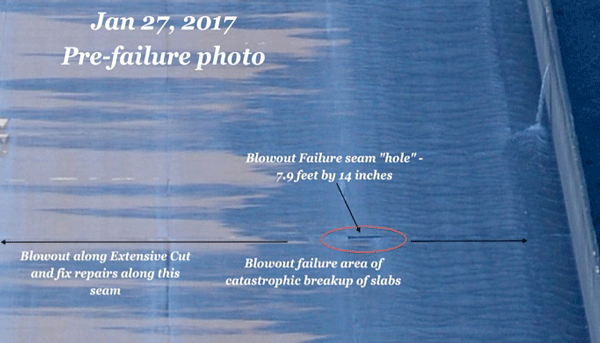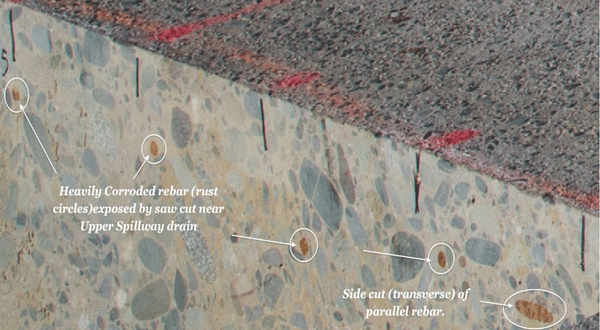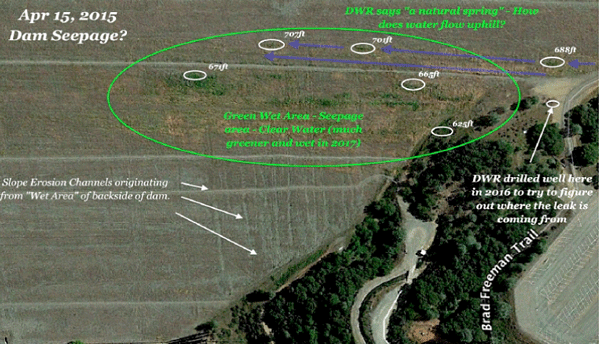A root cause analysis report1 from an independent engineering expert on the failure of the Oroville Dam spillway in California earlier this year accuses state and federal regulators of ignoring established guidelines and not properly managing risks or detecting flaws in the system.
A large portion of the 1,730-ft (527-m) concrete spillway disintegrated in early February 2017 after heavy winter rains had filled the reservoir to the brim. That failure led operators to deploy the emergency spillway, which sent water over a bare hillside. This, in turn, caused near-catastrophic erosion and forced the evacuation of more than 180,000 people from downstream areas.2
According to Robert Bea, a professor emeritus of engineering at the University of California, Berkeley (Berkeley, California), the progressive deterioration of the spillway could have been prevented if better standards, guidelines, procedures, and processes were used by regulators.
“The gated spillway was managed and regulated to failure,” Bea says, referring to both the California Department of Water Resources (DWR) (Sacramento, California) and the U.S. Federal Energy Regulatory Commission (Washington, DC).
Bea says he and other members of the university’s Center for Catastrophic Risk Management put in ~3,000 pro bono hours as unfunded volunteers to perform their forensic root causes analyses.
Design, Construction Flaws
Within the spillway itself, Bea’s team found a number of physical defects and flaws.
Specifically, Bea says the concrete base slabs had insufficient thickness for the designed hydraulic conditions and were only 4- to 6-in (102- to 152-mm) thick at minimum points. Other design problems with the base slabs were also cited, Bea says. They were not joined with steel reinforcements to prevent lateral and vertical separations and provide sufficient flexural strength, they were designed without effective water barriers embedded in both sides of joints to prevent water intrusion, and they had ineffective ground anchors.

Bea also notes a number of construction problems, such as voids in the foundation not being filled with concrete and a failure to prevent the spreading of gravel used as part of the drainage system. This gravel spreading allowed water to collect and erode, he says.
“The original design specified construction on rock and concrete, but the documents confirmed it was built on graded fill,” Bea says of his investigation.3 “Graded fill simply doesn’t provide the strength and stability that rock and concrete provide, as we saw in February, when huge portions of the spillway were destroyed and tremendous erosion occurred.”
While Bea says regulators have known about these flaws for years, he believes maintenance efforts were not sufficient. “Repeated ineffective repairs made to cracks and joint displacements to prevent water stagnation and cavitation pressure induced water intrusion under the base slabs with subsequent erosion of the spillway subgrade,” Bea says. In some cases, these ineffective repairs severely decreased water flow through the spillway drains.
In addition, large trees and other vegetation had grown adjacent to the spillway walls, Bea says, adding that the roots could then grow beneath the base slabs and intrude into the drainage system. This could result in reduced flow and plugging of the drainage pipes.
Years of Missed Opportunities
According to Bea, the Oroville Dam failure would have been preventable if regulatory agencies had recognized and investigated serious issues that could have led to effective remedial measures. He says the cratering of the main spillway in February occurred in a spot where cracks and other defects had been found for many years.

“The main portion of the spillway that blew out is a section known as Station 3300,” Bea says. “We found documents and photographs dating all the way back to a 1998 inspection report that confirmed there were major problems with this section. Essentially, they were screams for help that went largely ignored.”
“DWR tried patching cracks, even filling up voids, but on that structure, finding the hollow areas is like trying to find a stud behind a wall by tapping it with a hammer,” Bea explains. “There’s a lot of room for error, and the repairs were far from adequate. Also, some of the patches actually trapped water so it couldn’t drain out, and that further compromised structural integrity.”
“A superficial ‘patch and pray’ approach is not an acceptable safety and risk management process for important public infrastructure systems,” Bea says, adding that state agencies should have upgraded the Oroville Dam facilities beforehand while also taking steps to update the design, construction, operating, and maintenance standards.
Additional Concerns Found
While issues with the substructure were largely to blame for the February incident, Bea’s investigation also found serious problems with the headgates—which control water releases from the dam.
“There is a lot of corrosion, and there are large cracks in two gate control tendons,” Bea explains. “Some of the gates don’t even open and close all the way. They’re like refrigerator doors that just stay ajar.”

Bea was also alarmed by green grass growing on the abutments. “The grass shouldn’t be green in that part of California during the summer and fall,” Bea explains. “It should be brown. So when you see lush green grass, it indicates there’s seepage through the dam face. What’s particularly worrisome is evidence we found indicating this seepage has been going on for about 50 years. DWR says that it’s just some natural springs, and that it’s no cause for worry. But a natural spring in that area would have to flow uphill, which runs counter to the laws of physics.”
Next Regulatory Steps
The DWR is currently using its own investigative team of engineering experts to investigate the design, maintenance, and management of the Oroville Dam’s two spillways. While Bea is not part of that group, the DWR says it welcomes additional studies and would share Bea’s report with its forensic team.
Separately, the state’s main contractor, Kiewit Corp. (Omaha, Nebraska) is working on rebuilding the damaged spillway and hopes to have it operational again by November.
From Bea’s perspective, however, the Oroville Dam problems primarily trace back to a flawed regulatory approach that should also be addressed at higher levels of government. If not, the problems in California could occur again elsewhere.
“Dams should be viewed like nuclear power plants or jet airliners,” Bea says. “With both nuclear plants and passenger jets, there is tremendous emphasis on managing and minimizing risks, and that’s appropriate. But dams are treated like inert piles of dirt or concrete that have no potential for catastrophic failure, and that’s simply not the case.”
“Since word of our work has gotten out, we’ve had engineers and water managers contacting us from all around the country,” Bea adds. “The basic message is ‘Holy crap! We’re having the same problems with our dams.’ Oroville is just the most obvious signal of a national, systemic problem.”
Source: University of California, Berkeley, www.berkeley.edu. Contact Robert Bea, University of California, Berkeley—Email: bea@ce.berkeley.edu.
References
1 R.G. Bea, T. Johnson, “Root Causes Analyses of the Oroville Dam Gated Spillway Failures and Other Developments,” Center for Catastrophic Risk Management, University of California, Berkeley, July 20, 2017, https://drive.google.com/file/d/0Bz1I1mIutSEnbFJuVUJZWWNNVlU/view (Sept. 11, 2017).
2 “Oroville Dam crisis,” Wikipedia, the free encyclopedia, https://en.wikipedia.org/wiki/Oroville_Dam_crisis (Sept. 11, 2017).
3 G. Martin, “Bob Bea Takes Us on a Deep Dive Through His Dire Oroville Report,” California Magazine, University of California, Berkeley, July 27, 2017, https://alumni.berkeley.edu/california-magazine/just-in/2017-07-27/bob-bea-takes-us-deep-dive-through-his-dire-oroville-report (Sept. 11, 2017).